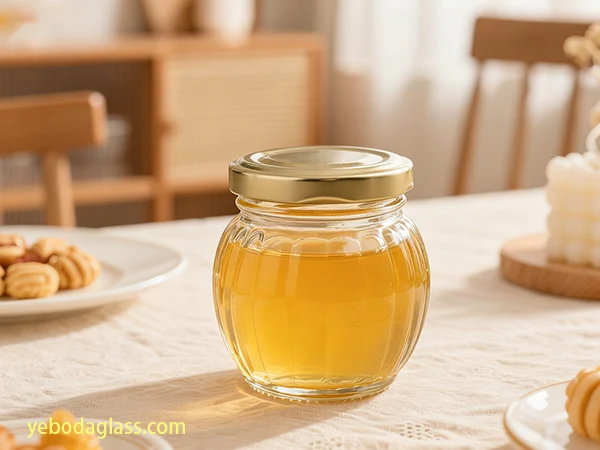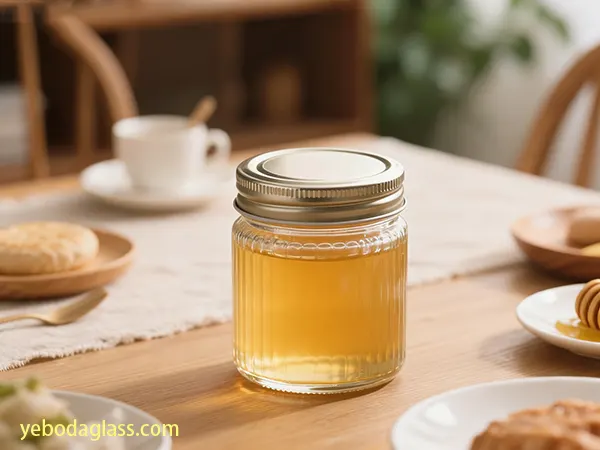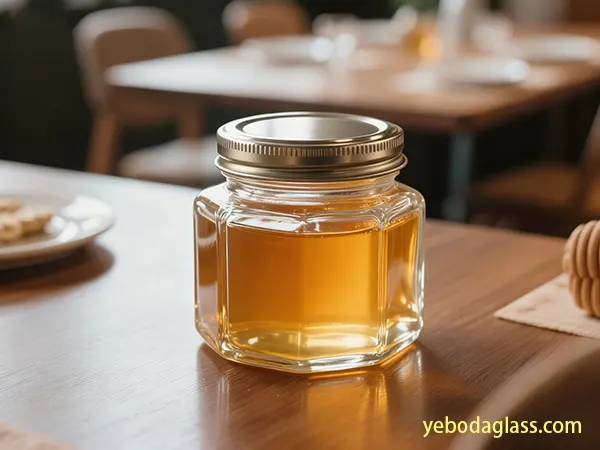Executive Summary
A professional honey jar manufacturer plays a vital role in shaping a brand’s market success. The right partner can transform packaging into a storytelling tool that reflects authenticity, craftsmanship, and eco-conscious values. As a leading honey jar manufacturer, Yeboda stands out for its advanced glass production technology, extensive customization capabilities, and strong focus on sustainability. Yeboda provides tailored solutions — from hexagonal and round glass jars to embossed and frosted finishes — ensuring every design aligns with your brand vision. Their use of high recycled glass content and energy-efficient furnaces also helps clients meet green packaging goals without compromising durability or aesthetics. This guide explores how to collaborate effectively with a reliable honey jar manufacturer, focusing on key areas such as material selection, customization options, supply chain reliability, and regulatory compliance, helping honey producers achieve lasting brand value and sustainable growth.

Brand-Specific Customization Requirements for Your Honey Jar Manufacturer
Conversion lies at the heart of luxury packaging. The best honey jar manufacturer knows that a jar is usually the user’s first physical and visual communication of the brand. Thus, the looks, the feel, and the practicality of the jar must be in harmony to create recognition and trust.
Unique Shapes and Molds: Building Brand Recognition
The shape of a honey jar is the quickest way of telling branding. Although regular jars are priced reasonably, they are not very recognizable. With the help of custom molds, companies are capable of achieving unique, easily identifiable shapesthat mirror their strategy.
- Concept Design: Using 2D art and 3D models to represent brand values, while taking into account aspects such as ergonomics, volume (8 oz, 12 oz, 1 lb), and filling efficiency.
- Prototyping: Leading honey jar producers use CAD/CAM modeling and 3D printing for prototype creation to get products tested physically before they go for mold production.
- Mold Fabrication: Precisely made steel molds can achieve not only the dimensional and shape uniformity but also the visual aspect of a glass honey jar that are of great value in the luxury market.
- Functional Optimization: The curved surface of a jar can be cleverly used to make the product more attractive to the consumers—big openings make scooping easy, whereas narrow necks give better pouring control and less dripping.
Besides giving the companies a way to differentiate their products, custom shapes can rep the brands stacking, labeling, and transport efficiency thus, providing operational advantages along the supply chain.
Embossed and Debossed Branding: Permanent Identity
A high-end honey jar manufacturer includes the options of embossing or debossing to permanently brand the elements such as the logo or the tagline on the jar body.
- Longevity: Being very resistant to fading and wear, thus, the logo will stay intact throughout the product life span.
- Luxury Element: Invites the consumer to touch the product and thus, increases the perceived value of the glass honey jars.
- Green Benefit: It helps by lessening the use of extra labeling materials, which is good for the recyclability process.
The intricacy of the design—character size, depth, and location—should be painstakingly worked out so that there is precision and brand clarity in each and every mass production run.
Color and Finish Customization: Functional and Aesthetic Excellence
Color serves the packaging both in terms of beauty and protection.
- Amber Glass: The perfect UV barrier, thus the honey’s enzymes and flavor stay intact.
- Green/Blue Tints: Communicate artisan or nature-based visual cues.
- Frosted or Opaque: Helps create a modern, minimalist style that can be used for high-end glass jars.
There are also surface treatments like acid etching, ceramic coating, and digital printing that brands can use to get attractive designs that not only entice consumers but also do not compromise the packaging.
Closure Compatibility and Design
A honey jar manufacturer with a lot of experience will guarantee that closures offer the product freshness and at the same time enhance the jar look. Some typical closure options are:
- Lug Caps: Airtight and tamper-evident, an excellent choice for glass honey jars.
- Screw Caps (Continuous Thread): Can be used with most products and are relatively cheap.
- Cork or Wooden Stoppers: Give small-batch honey the look and feel of the artisanal method.
- Flip-Top and Dispensing Caps: Make the use of liquid honey in plastic containers easy and convenient.
Both sealing efficiency and consumer-friendliness are very important. Usually, manufacturers suggest the use of liners with induction sealing or tamper-evident caps for packaging that is meant for export.
Material Specifications and Production Scale
Choosing the right material – be it glass, PET, or other polymers – is at the core of the cost, sustainability, as well as the looks balancing game. Each alternative comes with its own set of pros and cons that greatly influence the brand perception and supply chain dynamics.

Glass: The Premium Standard
Glass honey jars represent purity, tradition, and sustainability.
Advantages:
- Non-reactive, preserving honey’s flavor and composition.
- Excellent clarity to showcase natural color and viscosity.
- 100% recyclable, aligning with eco-conscious brand goals.
- Available in UV-protective amber variants.
- Disadvantages:
- Heavier, increasing shipping costs.
- Fragile, requiring careful handling and packaging reinforcement.
Still, for brands targeting premium markets, glass remains the most favored option due to its superior tactile and visual appeal.
PET and Alternative Polymers
PET jars provide flexibility for brands prioritizing lightweight packaging or lower logistics costs.
Advantages:
- Impact-resistant and shatterproof.
- Lower carbon footprint in transport.
- Flexible for squeezable bottle formats.
Limitations:
- Less premium image than glass.
- Limited thermal resistance for hot-fill honey processes.
Alternatives like PP (Polypropylene) and HDPE are used for specialized or opaque containers, depending on market positioning.
The following table provides a comparative overview of glass and PET as primary materials for honey jars, highlighting key considerations for selection:
| Feature | Glass Jars | PET Jars |
| Aesthetic Perception | Premium, Traditional, High-Quality | Modern, Practical, Lightweight |
| Weight | Heavy | Very Lightweight |
| Fragility | High (prone to breakage) | Low (shatter-resistant) |
| Inertness | Excellent (non-reactive) | Good (minimal interaction) |
| Clarity | Excellent | Excellent |
| UV Protection | Available (amber, colored glass) | Limited (can be added with additives) |
| Recyclability | High (infinitely recyclable) | Good (recycling streams exist, quality degrades) |
| Cost (Per Unit) | Higher | Lower |
| Shipping Costs | Higher (due to weight and protective packaging) | Lower |
| Design Flexibility | Moderate (complex molds are costly) | High (easier to mold complex shapes) |
| Heat Resistance | High (suitable for hot-fill) | Low (not suitable for hot-fill) |
| Scratch Resistance | High | Low |
Production Volume, Minimum Order Quantity, and Scalability of Honey Jar Manufacturers
A dependable honey jar manufacturer should match your supply needs:
- Low Volumes (<50,000 units): Perfect for niche or small-scale brands; higher cost per unit.
- Medium Volumes (50,000–500,000 units): Full automation of the production lines with the possibility of changing product.
- High Volumes (>500,000 units): Production is completely automated which allows for the reduction of the production cost per unit.
The understanding of a manufacturer’s Minimum Order Quantity (MOQ) and the ability to scale production is a guarantee for a stable supply of products in the long run.

Geographic Sourcing and Logistics Parameters
Local vs. International Sourcing
Location of sourcing majorly affects the cost, lead time, and risk management.
Local Sourcing:
- Lead times are short, quality is easier to manage, and there is a reduction in emissions of transport.
- There are higher costs in mature markets.
International Sourcing:
- Costs per unit of products can be cut, and one can gain access to advanced technologies (mainly in Asia) as well.
- Lead times are longer, and geopolitical risks, as well as tariffs, may affect business operations.
An expert honey jar manufacturer provides clear Incoterm options – usually FOB or CIF – and works with clients to determine the best method of transportation (sea, air, or rail) according to the volume and urgency of the shipment.
Supply Chain Management and Risk Mitigation
Advanced manufacturers who want to provide uninterrupted availability of glass jars do the following:
- They implement Vendor-Managed Inventory (VMI) systems.
- They establish more than one source for their raw materials.
- They take cargo insurance and also have a contingency logistics plan in place to deal with global disruptions.
They improve their operational resilience by diversifying their sourcing and making their supply chain transparent and digital (e.g., real-time tracking, predictive lead-time analytics).
Integrated Services and Value-Added Offerings
First-class honey jar manufacturer is not only a supplier but also—a full packaging partner.
Design and Prototyping Support
Full creative collaboration through CAD modeling, 3D visualization, and prototype sampling is a way of bringing not only design accuracy but also the cost-efficient mold development.
Labeling and Decoration
Value-added brand enhancement techniques, for instance, screen printing, hot stamping, or the use of shrink sleeves, help to turn glass honey jars into attractive assets of a brand, and at the same time, the complexity of the coordination process is reduced.
Filling and Co-Packing Services
Manufactures with integrated co-packing options deliver to honey producers co-packing facilities with ready-to-use solutions—filling, sealing, labeling, palletization, etc.—thus cutting handling costs and decreasing the risk of contamination.
Warehousing and Inventory Control
Using either VMI or consignment programs, the factory of honey jars is able to keep the inventory close to the area of the production, which not only optimizes the working capital but also guarantees an uninterrupted supply even during seasonal peaks.
Sustainability and Regulatory Compliance Mandates
Sustainability has become one of the main criteria in the process of supplier evaluation.
Environmental Sustainability Practices
A quality honey jar manufacturer will make sure to:
- Use of PCR Glass and rPET: Lessening the need for completely new raw materials.
- Energy Saving: When using clean and efficient heating systems.
- Waste Reduction: By the use of closed-loop recycling and zero-waste initiatives.
Besides enhancing the honey brand’s image, these measures also make it easier for farmers to meet the requirements of eco-labeling and carbon reporting.
Compliance and Food Safety Certifications
Honey packaging should be in line with the safety and traceability standards agreed upon globally:
- FDA (U.S.) and EU 1935/2004 regulations for food contact.
- Compliant BPA-free for all plastics.
- ISO 9001/14001 certifications.
- Each batch should be tested for migration with corresponding testing and certificates of analysis (CoA) provided.
Additionally, manufacturers exporting glass honey jars should satisfy the REACH and Prop 65 requirements for chemical safety and transparency.
Ethical and Social Accountability
The contemporary honey jar manufacturer should be able to feature good labor practices, raw material sourcing that is traceable, and provide open reporting for ethical audit purposes. Such pledges not only deepen the trust which is the basis of long-term relationships but also dovetail with ESG reporting which is increasingly required of B2B buyers.

Conclusion
Choosing the honey jar manufacturer that would fit your needs is way beyond simply negotiating the price. This decision, which is very strategic in nature, affects not only the brand of your company, its operational efficiency, and your environmental footprint but also the core of your business. A good partner will offer you:
- Extensive possibilities of personalization for unique, customer-ready glass honey jars.
- Environmentally-friendly material procurement and high technology production scalability.
- Combining logistics, co-packing, and inventory management into one seamless flow.
- Strict observance of safety and environmental standards on a global scale.
By cooperating with a capable honey jar manufacturer, honey producers will be able to ensure dependable quality, their supply chain will be more efficient, and their brand will be strengthened through the sustainability story – which in the end will give them a competitive advantage in the expanding global honey market.




